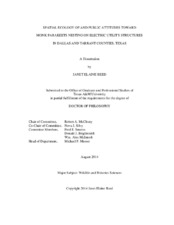| dc.description.abstract | Monk parakeets (Myiopsitta monachus) were introduced to the United States (US) where they established naturalized populations. They often build their bulky twig nests on electric utility structures, causing economic damage. From May 2010–February 2013, we examined the spatial ecology of and public attitudes toward monk parakeets nesting on electric utility structures in Dallas and Tarrant counties, Texas, US.
As nest sites, monk parakeets selected electric switchyards and substations constructed with multiple flat surfaces and acute-angles, within small fenced areas, with large canopy trees and taller anthropogenic structures within 100 m. Multi-scale analysis of urban land use-land cover (LULC) suggested the surrounding landscape had little impact on nest-site selection.
Monk parakeets used canopy LULC more often than pavement, grass, buildings, or water. They traveled farthest from their nests during winter. Flock sizes were highly variable, yet largest during nonbreeding season. They foraged on a broad range of native vegetation and exhibited a diverse diet of flowers, fruits, acorns, grass blades, wild dry seeds, leaf buds, insect larvae, and commercial bird seed.
We evaluated sociological variables as predictors of opposition to managing monk parakeets nesting on electric utility structures. Most survey participants were affluent, well-educated, older Caucasians who were unknowledgeable about, inexperienced with, and unsure about the impacts of monk parakeets. They indicated least opposition to nest removal and structural modification. When opposing, they would most likely do so socially and through petitions. Participants were influenced by their desire for monk parakeets to feed at their bird feeders or nest in their yard, people and groups important to them, and their perceived ease of opposing.
Our results suggest LULC manipulation and food-based strategies are not reasonable for controlling urban monk parakeets. We recommend an outreach program explaining monk parakeet biology and the impacts of their nesting habits. We suggest targeting affluent areas adjacent to electric structures with nests and the predictors driving participants’ behaviors. To provoke least opposition, we advise nest removal and structural modification. We recommend electric companies conduct cost-benefit analyses exploring feasibility of modifying construction elements preferred by monk parakeets and redesigning new construction to reduce risk of future nesting on electric utility structures. | en |


